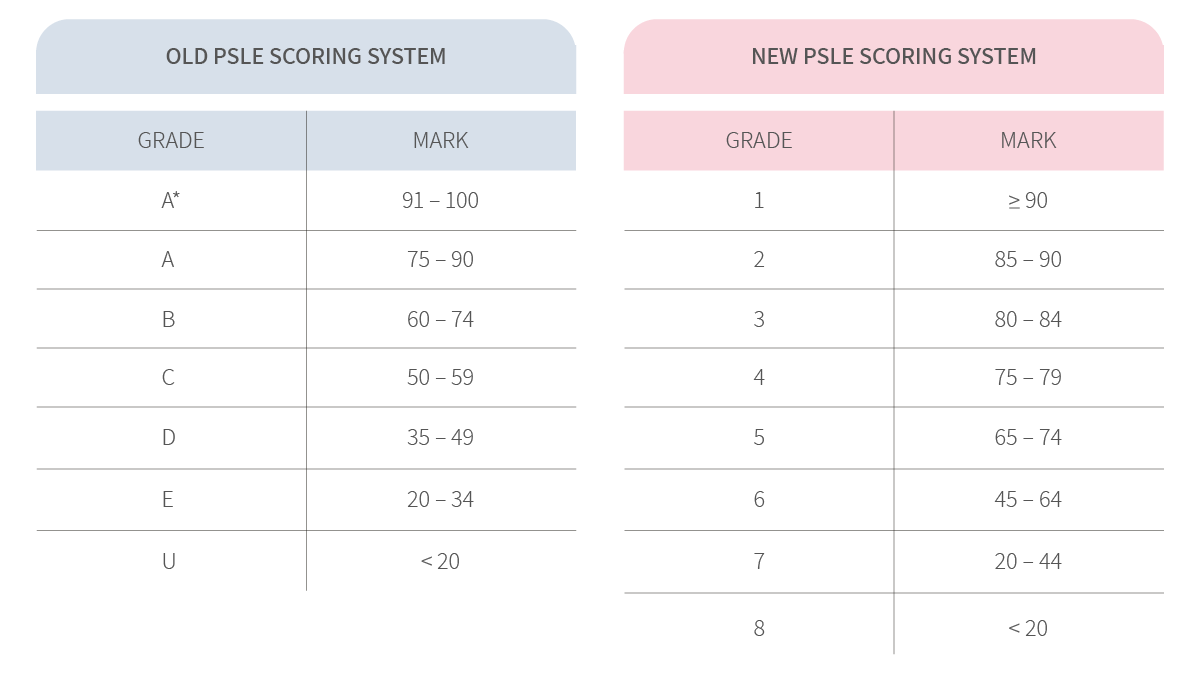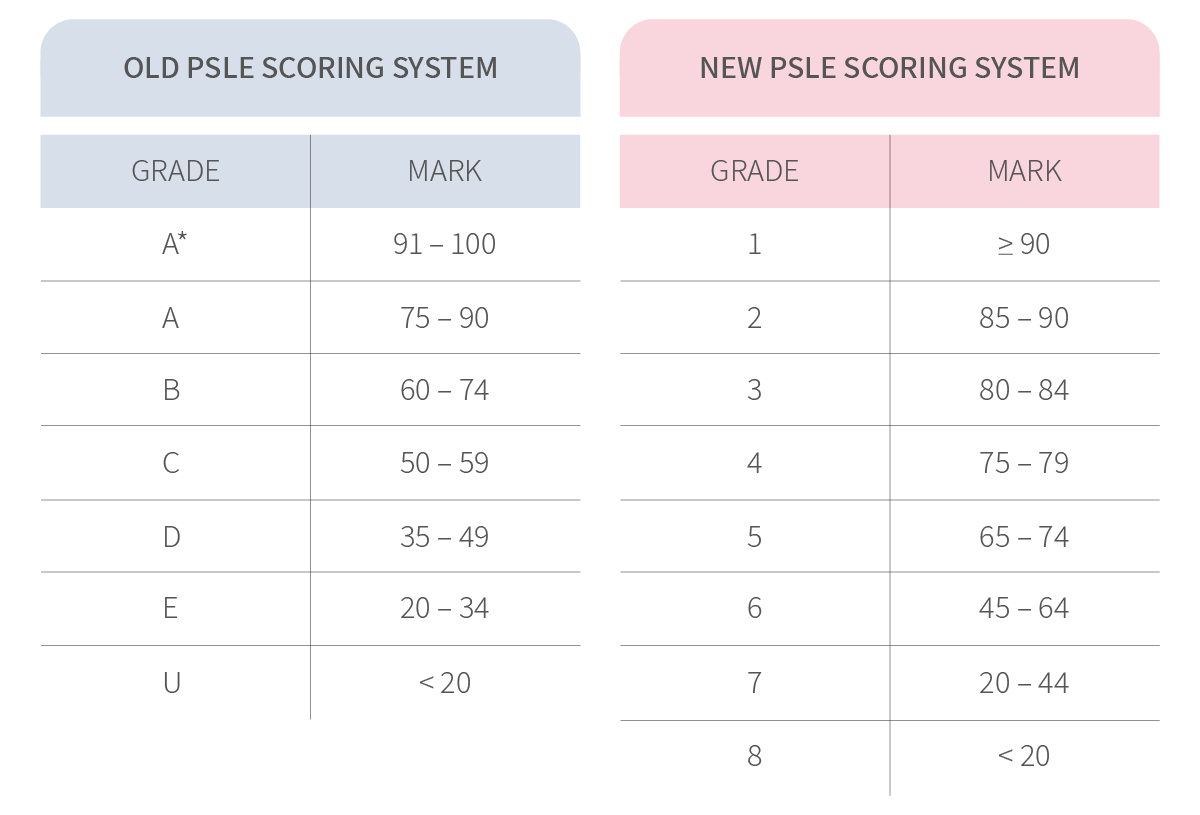
First announced in 2016, the revamped Primary School Leaving Examination (PSLE) scoring system that replaces the old T-score system takes effect this year. The Ministry of Education released the entry score ranges for 139 secondary schools that the 2021 Primary 6 cohort will need to meet in order to get accepted.
Here is everything you need to know about this overhaul of the PSLE scoring system:

1. "The PSLE AL scoring system"
Under the AL system, each standard-level PSLE subject will be scored using eight bands known as Achievement Levels (ALs). Each student will be given AL scores from 1 to 8 for each subject, corresponding to the range of marks in the table below:


A pupil’s total PSLE score will be the sum of ALs for his or her four subjects, with the best possible total being 4.

2. "How were the schools’ entry and cut off scores for this year generated, since this is a new scoring system?"
The MOE said the scores were generated by recalculating the 2020 PSLE cohort’s scores using the AL system, and then simulating each pupil’s posting outcome based on that score and the new posting system.
The score ranges for each school reflect the scores of the first and last pupils who would have been posted there under the AL scoring system. For example, Raffles Institution’s indicative score range is 4-6, which means that the cut-off point for the school (or the score of the last pupil posted there) is 6.

2. "What are the key differences and changes between the new PSLE AL scoring system in 2021 and the previous PSLE scoring system?"
The main difference is that PSLE scores will become much less finely differentiated. Under the AL system, students gain entry to schools based on a maximum of 29 possible scores (from the best possible score of 4 to the worst of 32), compared to more than 200 possible aggregates under the old system.
For example, let’s say Student X would have scored 271 under the old system, and Student Y 270, leading to the inevitable comparisons. Under the new system, however, they are very likely to receive an identical score of 4. According to MOE, the new AL system is meant to reduce stress for students and parents who will no longer have to chase that last mark to outperform their peers.
You may also have noticed that the lower AL bands have a wider marks range than the upper bands. According to the MOE, this decision was also made to reduce fine differentiation, because students’ scores are more widely distributed at the middle to lower ALs compared to the upper ALs. The wider marks range is sufficient to give a good indication of a student’s understanding.
In other words, MOE is trying to help the students at the middle to lower ALs who would have had a wide variety of scores under the old system to apply for admission on a more equal footing. Finer differentiation is needed with the upper AL bands to avoid too many tie-breakers because around half of the cohort is expected to score above 75 for their subjects.

3. "Sounds like there will be more students with equal scores, and more schools with the same entry score ranges. How will posting be decided in the case of a tie? Will there be more balloting?"
According to the MOE, postings to secondary schools will “still be based on academic merit”.
Tie-breakers will be used if more than one student with the same score is vying for a last available place in a school, in the following order:
- Citizenship: A Singapore citizen has the highest priority, followed by PRs and lastly international students
- School choice order: A student who ranked the school higher on his or her list of choices gets priority
- Balloting: If the above two are the same, computerised balloting will be used to determine who is to be admitted.
The ministry added that, based on its simulations, about 9 in 10 students will not need to undergo balloting.

4. "How can I tell which school is better if more schools will have the same entry score range?"
Parents and students are encouraged to look beyond schools’ PSLE score ranges when choosing a secondary school, and consider a school based on its overall fit for students’ learning needs.
These other factors include schools’ programmes and initiatives, co-curricular activities, ethos and culture as well as home-school distance. In other words, when choosing between two or three schools with the same entry score range, pick the one you and your child like best!

5. "I heard that the changes will make the PSLE more difficult for my child. Is that true?"
This is not true. No official statement has been released about changes to the PSLE curriculum and how your child will be assessed.
While our teachers and curriculum specialists have indeed noticed that questions requiring the application of higher-order thinking skills have been increasing in frequency and weightage, the higher complexity of PSLE questions does not directly correlate to the new changes in the PSLE scoring system.
Such questions have been a feature of the PSLE for many years, but they are now appearing more regularly as the MOE’s focus has shifted to a more skills-based approach in all four of the PSLE’s examinable subjects (English, Mother Tongue, mathematics and science). Rather than relying on rote memorisation, students are increasingly encouraged to think out of the box, adapt to the requirements of more sophisticated questions and apply the concepts they have learnt in new and innovative ways.
These types of questions ask for more than the mere regurgitation of facts and assess students on how well they can connect and apply, as well as reason and justify. To give you a clearer idea of how questions on the PSLE are evolving, our curriculum teams have provided illustrative before-and-after examples below — one set each for English, Mathematics and Science.
In this English PSLE comparison guide, our P6 teachers examine and demonstrate how the composition and comprehension components differ in difficulty and complexity throughout the years.
In this Maths PSLE comparison guide, our P6 teachers show how rote learning can no longer be used to solve questions, as there are more questions which require higher-order thinking and logical reasoning skills.
In this Science PSLE question guide, our P6 teachers share about the varying complexities of current Science questions that test students’ depth of knowledge, and the requirements to derive answers.

6. "Will the new PSLE AL scoring system make getting into my child's preferred school more difficult?"
Parents who ask this question are wondering if their child will be penalised for doing equally well under the new scoring system compared to the old scoring system. The answer lies somewhere between ‘No’ and ‘You can’t tell anyway’.
The odds are much higher that your child will either qualify comfortably for their new school, or fail to qualify in a clear-cut manner. To reiterate, the MOE has said that it expects only 1 out of 10 students to need to undergo balloting according to its simulations.
Secondly, there is no way you can tell anyway whether your child has been “disadvantaged”. Whether new system or old system, AL or grade, students are not given their individual scores for each subject in their PSLE transcript. So parents and students had no way of telling if a ‘B’ grade referred to 64 or 74 marks, and they will still have no way of telling if an AL 6 grade refers to 64 (a ‘B’ grade under the old system) or 54 marks (a ‘C’ grade), for example. You might think your child has been penalised, but you won’t know for sure.

Recalibrating for Success in the PSLE
Regardless of the scoring system used, the PSLE remains a major academic milestone in your child’s life that he or she will need to prepare adequately for.
Find out more here about how you can equip your child with the tools to ace the PSLE with our highly-trained teachers, targeted pedagogy and customised curriculum.
Resources for Your Child's PSLE Journey
At The Learning Lab, we have a wealth of resources you and your child can benefit from to gear up for success in the PSLE. Read our other articles that break down each PSLE component in detail and impart strategic advice and study tips.
The complete overhaul of the PSLE scoring system from 2021 onward is doubtlessly daunting. But with our detailed breakdown in hand, you can ensure that both you and your child will be more than prepared for the challenges coming your way.
Ever find yourself constantly nagging at your child to study for the PSLE? We understand your frustration. However, your child may have valid reasons for "slacking off". Read on to gain an insight into your child's mind.
Find valuable tips on ways to help your child master the content covered in exams, hone key exam skills and how to exercise the right habits and attitudes to make this road towards the PSLE as rewarding as it is meaningful for your child.
Gear Up for the PSLE
The PSLE is a huge milestone in your child's academic life. Ensuring that your child has everything they need in the lead-up to the major exams will allow them to focus on effective, efficient and productive learning.
Click here to find out more about our proprietary game plan that will gear your child up for PSLE success.
The Learning Lab is now at locations. Find a location that suits your needs.
If you have any questions about our range of programmes or class schedules, you may contact us at 6733 8711 or drop us an email at enquiry@thelearninglab.com.sg.
The Learning Lab is now at locations. Find a location that suits your needs.
If you have any questions about our range of programmes or class schedules, you may contact us at 6733 8711 or drop us an email at enquiry@thelearninglab.com.sg.







![[TLL PSLE E-Book] Chapter 1: A Parent’s Guide to the PSLE](https://www.thelearninglab.com.sg/hubfs/Imported_Blog_Media/28-Mar---PSLE-Guidebook-Chapter-1-Jul-16-2024-03-18-59-6645-PM.jpg)
